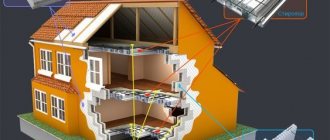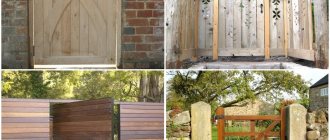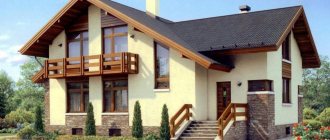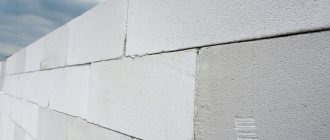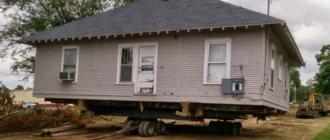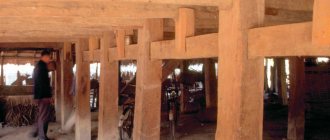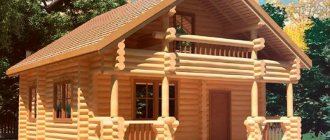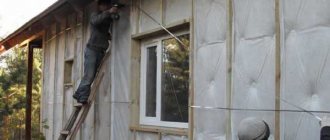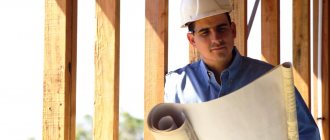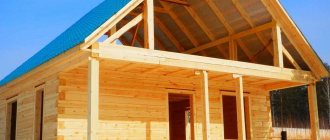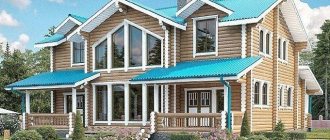If there had been no development in the field of building materials, we would still be living in the Stone Age. Fortunately, this area is actively developing, patents are regularly filed for all new inventions, and one development is better than the other.
Foundation calculation
Try a new product
Try for free Find out more
Thanks to this, completely new unique products are entering the building materials market. Each material finds its own niche of application and earns its own applause. Let's get acquainted with the latest developments, which are already presented in many building materials stores.
Self-healing concrete
The Netherlands was ahead of the curve by providing a solution to an important problem in modern construction: houses don't last, but that will soon be a thing of the past.
Now there is cement that can repair itself. Calcium lactic acid and some bacteria will motivate him to such an amazing accomplishment. They process calcium, turning it into limestone, which in turn will fill various cracks, preventing them from further growing.
Composite material that can replace concrete
Substitute for concrete
Its main advantage is that the composition, when hardened, can protect the metal from corrosion and rotting. But concrete will not provide such protection, since it contains moisture in its composition.
You can work with it at outdoor temperatures down to minus 25 degrees.
This composite consists of a hardener and filler, which are sold in two different containers. When using them, you need to mix them and pour them into the right place. It takes only one hour for the mass to increase in volume and harden.
Good to know! The concrete substitute is used more economically, since it is needed fifty times less than cement mortar. It is completely safe for health and does not generate dust.
Prices for concrete substitute
concrete substitute
Quartz vinyl floors
In addition to laminate, linoleum, parquet, porcelain tiles or tiles, there is also quartz vinyl. Now this coating is becoming increasingly popular due to its positive qualities.
The material is resistant to both fire and water, as it contains quartz sand. By adding plasticizers, the tiles become flexible. Thanks to stabilizers that protect the coating from UV rays and high temperatures.
The future belongs to building materials from waste
Science and construction technologies are moving forward by leaps and bounds. Scientists around the world are driven by the desire to solve two problems at once: recycling industrial waste and providing cheap and environmentally friendly building materials. And they have already achieved something in this direction. For example, foam plastic made from wood and façade material made from rice husks have become a reality. Read about these and other know-how in our review.
A team of Dutch researchers three years ago invented a biocement capable of self-repairing. Scientists have come up with the idea of using special bacteria that “tighten” cracks in concrete. To do this, they proposed combining traditional cement with bacterial mass and calcium lactate capsules. When cracks appear in the concrete over time, sooner or later water will seep into them and “activate” bacteria, which feed on calcium lactate. By eating it, bacteria will produce calcite, which will fill all the breaks and cracks.
At the moment, a building that can repair itself already actually exists - this is a rescue station on the lake. Scientists recorded a video in which they share their joy that their idea really works. They observed how bacteria produced limestone to repair the walls of a house.
“Wood foam” is an innovative material that received the GreenTec-2015 award in the “Construction and Living” category.
The wood is crushed to a viscous mass. It is then foamed by adding gas. Hardening and hardening occurs due to natural substances contained in wood. The result is a very light, environmentally friendly material that can be formed into both thick solid panels and thin flexible layers. Finished wood foam can be easily cut into pieces of the desired size.
Wood-based material is a good solution for thermal insulation of a house. Compared to chipboard and wood fiber wool, foam is highly resistant to moisture and mechanical stress.
ECOR is another innovative material developed by the American company Noble Environmental Technologies. It is a fibreboard (fibreboard) pressed from waste fibers at high temperatures.
The new material is certified by the USDA as 100% recycled cellulose-based bio-based product. The source of raw materials for ECOR can be old cardboard, newspapers, office paper, wood shavings, coffee, coconut, oat husks, as well as residual agricultural fibers, including cattle manure.
The new “green” building material looks like corrugated cardboard. Of course, in structure and properties, ECOR is similar to other products in its category - plasterboard, composites, chipboard. But its advantage is that it is 75% lighter than conventional panels. The inventors claim that corrugated cardboard made from cellulose waste can be used for construction, furniture manufacturing, interior design elements, for the production of consumer goods, packaging, and signs.
Biocomposite reinforced facade material Resysta is a product of the American company Resysta North America Inc. – also meets all modern environmental requirements.
More than half of it consists of rice husks, almost a quarter of table salt and 18% of mineral oil. According to the manufacturers, Resysta is resistant to moisture, salt water and ultraviolet radiation. Panels made from the new façade material look like tropical wood and do not require special maintenance. They can be subjected to any processing, and, due to their high strength, the appearance of cracks and chips is excluded. In addition to its main purpose, the material is ideal for the production of outdoor furniture, yacht decks and outdoor terrace coverings. It can be used for outdoor pools, because Resysta is not afraid of mold and mildew.
There are also new technologies in the production of ceramics. For example, the Spanish company Flexbrick released a flexible building material of the same name. It consists of blocks of baked clay woven together with steel wire. Modern building material opens up endless prospects for architects and designers - flexible ceramic sheets are suitable for creating structures of any curvature.
By changing only one indicator - the thickness of the ceramic blocks, Flexbrick can be used as a covering for roofs, floors, walls, facades, vaults, as well as for various landscaping works, strengthening slopes, elements of street architecture or road surfaces.
Another new ceramic material can accumulate heat and release it with slight compression. Employees at the University of Tokyo report that the heat-sensitive ceramics they invented can collect thermal energy from the sun, use electric current, and also the energy of virtually any device with moving parts.
We recently wrote about eco-friendly bricks and other innovative developments by scientists. Find out from this article whether non-traditional construction technologies are profitable. And our forum members do not doubt this, and build houses from straw and expanded clay and hotly discuss housing made from organic raw materials on FORUMHOUSE.
Thermal wallpaper
You can buy regular wallpaper, but it’s better to make repairs by covering the walls with new thermal wallpaper. Such canvases can surprise you with new patterns if the temperature in the room or objects adjacent to the walls changes.
The key role here is played by the thermal paint applied by the manufacturer to the canvas.
If the room temperature is low, then the eye sees a certain print, but when the temperature rises closer to 23°, the flower buds may increase, and if it gets even hotter, flowers will literally bloom on the walls.
Foam concrete
Cellular structure, the basis of which is lime, slag, ash, magnesium, cement binders. The foam concrete mass consists of water, quartz or river sand, binder mortar, various ore products, foaming agents, plasticizers, strength stabilizers, and hardening accelerators. Due to its porous structure, foam concrete is much lighter than traditional concrete. This helps to significantly reduce the load on the foundation and eliminate the need for heavy-duty and expensive building materials. In turn, construction becomes cheaper. Foam concrete can be used for the construction of walls using removable and permanent formwork. This method is possible if there is special equipment at the construction site. In most cases, foam concrete is delivered to the construction site pre-formed into blocks. The geometrically correct shape of the foam blocks allows them to be quickly installed using a special adhesive mass. And even, smooth surfaces do not require large consumption of plaster and putty solutions, which also reduces the cost.
Construction wooden block: new types
Wood has long been the world's building material. But Russian manufacturers have come up with something new: an element has appeared that allows you to save on building materials and prevents massive deforestation.
This element is called DPB - a hollow wooden block.
Thanks to the use of DPB, a vacuum layer appears inside the building, which makes the material first-class in terms of heat preservation. Shrinkage is minimal, which makes the element even more attractive.
Apart from this, there is an option which is also called wooden building block. It is made from short-length lumber: this is an element consisting of cut and dried boards, and all parts are equal in width and length.
A block is assembled from packages; vertical boards of the same length play an important role. No level or plumb line is needed for alignment.
Frame technology
The construction of frame houses is a relatively new method for our country, but it is actively used abroad. It has a number of advantages:
- You can save on the foundation.
The structure will be lightweight, so there is no need for an expensive base. Despite the lightness, the frame house is stable - it is not afraid of seasonal movements of the foundation due to soil movement. - Construction is being carried out in a short time.
A fairly large mansion with an area of up to 200 m2 takes about 8 weeks. This is one of the fastest results. For example, when building a brick house of the same area, it will take about 8 months. - No shrinkage.
In ordinary houses, finishing work cannot begin without waiting about a year. The frame eliminates this problem - you can move in immediately. - High energy efficiency.
The material has low thermal conductivity, which means you don’t have to spend a lot of energy to heat the rooms. - Ecological cleanliness.
The radioactivity level of the material does not exceed 15%. Compare - with concrete it reaches 60%!
Foam siding
Foam siding is also popular. Its texture is similar in appearance to wood, which also explains its popularity in finishing the facades of houses. The result is an original and high-quality solution for finishing the building.
The siding consists of foamed polyvinyl chloride, which explains its solid thickness compared to its predecessor. The cost of the product is high, since it takes a lot of material to make it.
Warm wall
Another innovation in the field of bricks is a block called “thermal wall”. It was invented in 1999. The thermal wall is presented in the form of a block, which consists of three layers. The first layer is a load-bearing block that carries the main load, the second is a layer of insulation, usually polystyrene, less often mineral wool, and the last is a decorative facade layer. The thermal conductivity of such a block is 6 times higher than that of ordinary brick. The heating wall is installed using tile adhesive, which is applied in a thin layer, which eliminates the appearance of efflorescence on the wall surface. This material has a large variety of configurations and design options. It is also possible to manufacture custom blocks. These blocks have no equal in thermal conductivity; they can retain both heat in winter and coolness in summer. Thermal walls can deservedly be called the material of the future, thanks to its efficiency, speed and ease of installation and a wide variety of facade design options.
"Live" tiles
A new product on the building materials market captivates with its originality. As soon as you step on it, it changes the pattern - a completely innovative material.
A polycarbonate capsule in a certain geometric shape is built into the tile. There is a colored gel inside it. When weight is applied to the tile, the gel begins to spread and move inside. If you remove the pressure, the pattern returns to its original boundaries.
Cleaning “live” tiles is just as easy as regular tiles. If desired, you can decorate any flat surface with this material.
Unfortunately, such an item of innovative technology does not like low temperatures and scratches.
Dye
The market offers a truly huge number of all kinds of interior paints. Water-based ones are considered the safest and non-toxic, while organic-based ones, when dry, form a denser, shiny layer. You can choose moisture-resistant paint, which is suitable for the kitchen, and vapor-permeable paint, which would be appropriate, for example, in the hallway.
As for decorative properties, paints come in glossy, matte and even embossed. The former are suitable for perfectly smooth surfaces, while the embossed one can hide roughness and small errors on the walls.
- Water-based paints have the “softest” chemical composition. Their other advantages include an attractive price and a huge selection of colors and shades. Disadvantages include instability to abrasion and high humidity.
- Acrylic paints are more tolerant of fumes, but drops or streams can destroy them. The most durable among water-soluble paints are latex paints. They can even be washed, but they are not very tolerant of ultraviolet radiation, and they are more expensive. Walls coated with acrylic-based paint are not afraid of sunlight, are non-toxic and do not fade for 15-20 years. The disadvantage of such paints is their long drying time.
- Alkyd paints are inexpensive, easy to use, have a wide range of colors and dry within an hour after application. True, alkyd-based dyes are short-lived - a year later, the walls may become stained and lose their original brightness. They also do not like sunlight, and most importantly, they are quite toxic. In connection with the last point, these paints are not recommended for bedrooms and children's rooms.
- Silicate paints are created on the basis of liquid glass with the addition of pigments and fillers. Most often they are used on verandas, balconies, and basements - where resistance to moisture and temperature changes is required.
- Silicone paints are vapor-permeable, have dirt-repellent properties, are not afraid of water and create a fairly durable coating layer. It is not surprising that their service life is a quarter of a century. Silicone paints can be used to decorate bathroom walls, use them in the hallway, and in the kitchen. It should, however, be remembered that the bumps and depressions on walls covered with this relatively new type of paint and varnish products will become more noticeable.
- Oil paints with drying oil as a base are rarely used today for interior decoration. The reason is the harmful components that are used in their production. In addition, oil compositions take a long time to dry, do not allow surfaces to “breathe”, and can bubble and crack. The merits of oil paints include, perhaps, their affordability. Because of this, oil paints can be useful in utility rooms and utility rooms - they are used to paint pipes, window frames, and heating radiators.
- Enamel is often called upon to help when renovations are underway. Among the advantages of enamel dyes are a budget price, aesthetics (it forms a smooth, glossy film), and durability that exceeds the durability of oil and alkyd paints. Enamel is called a universal coating because it easily applies to any surface, be it brick, concrete or wood, and dries within 24 hours. Paint resists moisture well, which is why bathroom walls are sometimes covered with enamel. But we must not forget that enamels are fire hazardous, which is why they should not be used near a stove. The durability of enamel paint depends on the type and ranges from 10 to 15 years.
liquid tree
German specialists decided to take a completely unexpected step and created an innovative material: bending wood is not so simple, so why not immediately make some kind of liquid composite from polymers and crushed wood?
The polymers in the composition can be organic or synthetic, and various modifiers are also added. Wood is found as wood flour and makes up up to 70% of the bulk of the composite.
The composite may not contain wood; straw, rice husks, or hemp can be added to the material.
Organic modifiers include casein, grain starch, and paper production waste. The inclusion of such components of organic origin allows you to reduce the final price of the product.
If the composition includes antimicrobial components, temperature stabilizers or substances that make the material shockproof, then the price rises accordingly, as does the quality.
It’s still great that time keeps production moving, making work easier during construction and repairs. It’s also nice that many developments are environmentally friendly and economical in terms of benefits. We look forward to further useful innovations in this area!
Rolled concrete - a new material for construction
This concept was developed by French architects and designers from Cutwork. It will take only one day to build such a house!
Model of a house made of rolled concrete
In order to set up a concrete tent, you just need to add ordinary water to the solution. The houses are delivered to the construction site ready-made; all that remains is to assemble them.
Easy assembly
The material with which it is possible to create such a unique house is patented. The initial concept of the studio is to build comfortable houses for refugees in which it will be convenient to live. But who knows where their idea might lead? Perhaps in a couple of years it will be possible to build a country house from scratch in just one day.
Prices for rolled concrete
rolled concrete
Aerated concrete
A very affordable material, but with excellent construction characteristics. Among its advantages is the combination of the lightness of wood with the strength and durability of stone. The absolute environmental safety of aerated concrete is determined by its composition. The solution consists of water, cement, fine aggregate and a blowing agent. Technologies for using aerated concrete make it possible to erect buildings in the shortest possible time. Polystyrene concrete A modern, revolutionary product. The composition of the material is based on a mixture of Portland cement, mineral fillers, water, air-entraining additives and a porous structure - granulated polystyrene foam. The material is durable, environmentally friendly, fireproof. The favorable combination of price and quality makes the material very popular in low-rise construction. It makes not only good walls, but also wonderful, insulated floors. Advantages include vapor permeability, resistance to fungi and moisture.
